Search Result
| Isoforms Recommended: |
CYP2
|
Results for "
CYP2C8
" in MedChemExpress (MCE) Product Catalog:
1
Biochemical Assay Reagents
8
Isotope-Labeled Compounds
| Cat. No. |
Product Name |
Target |
Research Areas |
Chemical Structure |
-
- HY-N0319
-
|
|
Cytochrome P450
|
Cancer
|
|
Salvianolic acid C is a noncompetitive Cytochrome P4502C8 (CYP2C8) inhibitor and a moderate mixed inhibitor of Cytochrome P45022J2 (CYP2J2), with Kis of 4.82 μM and 5.75 μM for CYP2C8 and CYP2J2, respectively.
|
-

-
- HY-135810
-
|
Desethylhydroxychloroquine
|
Influenza Virus
Parasite
|
Infection
Inflammation/Immunology
|
|
Cletoquine (Desethylhydroxychloroquine) is a major active metabolite of Hydroxychloroquine. Cletoquine is produced in the liver by CYP2D6, CYP3A4, CYP3A5, and CYP2C8 isoenzymes. Cletoquine is also a Chloroquine derivative and has the ability to against the chikungunya virus (CHIKV). Cletoquine has antimalarial effects and has the potential for autoimmune diseases treatment .
|
-
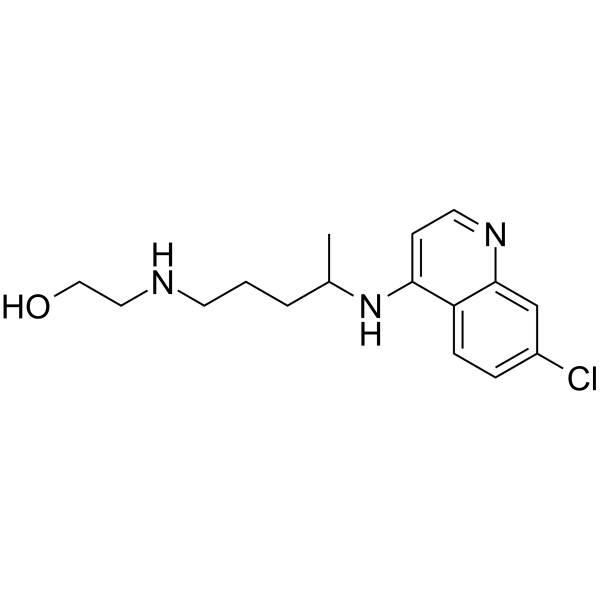
-
- HY-135331
-
|
|
Androgen Receptor
Cytochrome P450
|
Cancer
|
|
N-Desmethyl Apalutamide is an active metabolite of Apalutamide. N-Desmethyl Apalutamide is a less potent antagonist of the androgen receptor and is responsible for one-third of the activity of Apalutamide. The formation of N-Desmethyl Apalutamide mediated predominantly by CYP2C8 and CYP3A4. N-Desmethyl Apalutamide is moderate to strong CYP3A4 and CYP2B6 inducer and has an excellent plasma-proteins bound concentration .
|
-
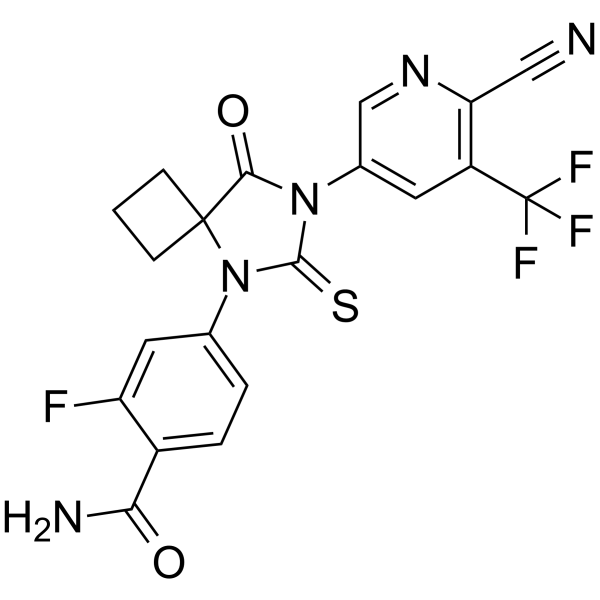
-
- HY-RS03459
-
|
|
Small Interfering RNA (siRNA)
|
Others
|
|
CYP2C8 Human Pre-designed siRNA Set A contains three designed siRNAs for CYP2C8 gene (Human), as well as a negative control, a positive control, and a FAM-labeled negative control.
|
-
CYP2C8 Human Pre-designed siRNA Set A
CYP2C8 Human Pre-designed siRNA Set A
-
- HY-135335
-
|
|
Drug Metabolite
|
Metabolic Disease
|
|
3'-Hydroxy Repaglinide is a main CYP2C8 metabolite of Repaglinide. Repaglinide is a carbamoylmethyl benzoic acid (CMBA) derivative, which recently has become available for the treatment of type II diabetes .
|
-

-
- HY-135335S
-
|
|
Drug Metabolite
|
Metabolic Disease
|
|
3'-Hydroxy Repaglinide-d5 is the deuterium labeled 3'-Hydroxy Repaglinide. 3'-Hydroxy Repaglinide is a main CYP2C8 metabolite of Repaglinide[1].
|
-
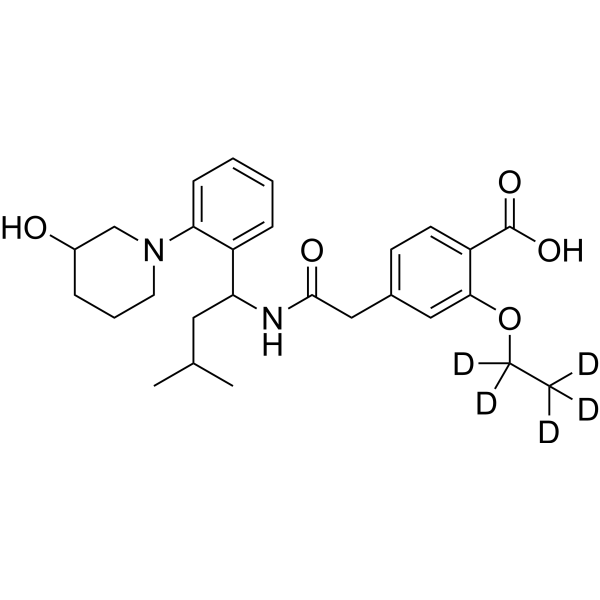
-
- HY-135810A
-
|
Desethylhydroxychloroquine oxalate
|
Influenza Virus
Parasite
|
Infection
Inflammation/Immunology
|
|
Cletoquine oxalate (Desethylhydroxychloroquine oxalate) is a major active metabolite of Hydroxychloroquine. Cletoquine oxalate is produced in the liver by CYP2D6, CYP3A4, CYP3A5, and CYP2C8 isoenzymes. Cletoquine oxalate is also a Chloroquine derivative and has the ability to against the chikungunya virus (CHIKV). Cletoquine oxalate has antimalarial effects and has the potential for autoimmune diseases treatment .
|
-

-
- HY-100641
-
|
Hydroxytolbutamide
|
|
|
|
4-Hydroxytolbutamide (Hydroxytolbutamide) is a metabolite of Tolbutamide. 4-Hydroxytolbutamide is metabolized by CYP2C8 and CYP2C9. Tolbutamide is a first generation potassium channel blocker and a sulfonylurea oral antidiabetic .
|
-
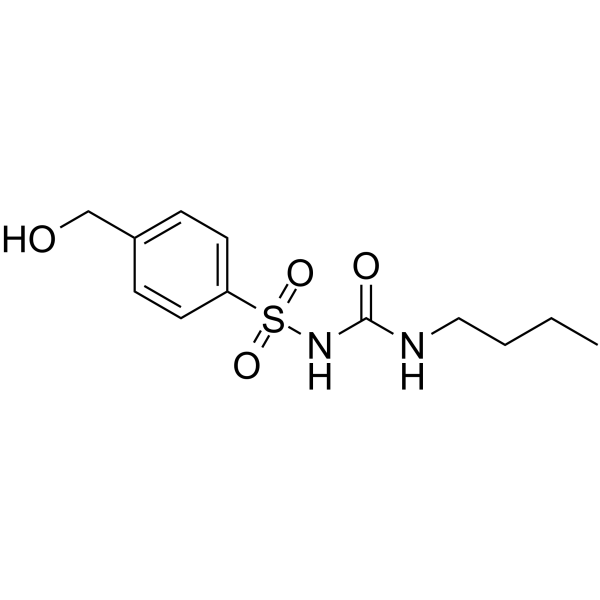
-
- HY-155376
-
|
|
mTOR
|
Cancer
|
|
mTOR inhibitor-14 (compound 14c) is a potent mTOR inhibitor. mTOR inhibitor-14 also shows minimal CYP2C8 inhibition. mTOR inhibitor-14 can inhibit tumor growth .
|
-
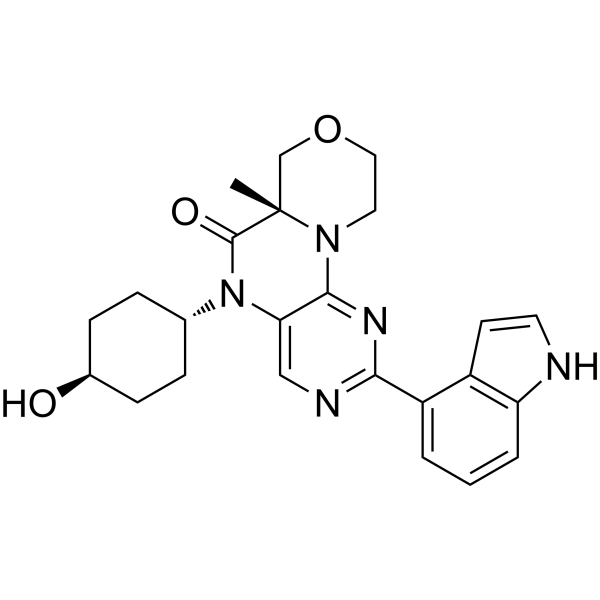
-
- HY-129993
-
-
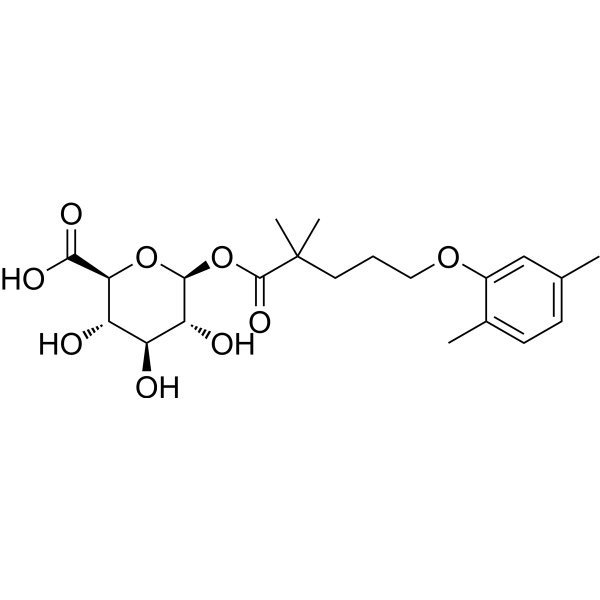
-
- HY-W754151
-
|
|
Isotope-Labeled Compounds
|
Others
|
|
N-Desmethyl apalutamide-d4 is the deuterium-labeled N-Desmethyl-Apalutamide (HY-135331). N-Desmethyl Apalutamide is an active metabolite of Apalutamide. N-Desmethyl Apalutamide is a less potent antagonist of the androgen receptor and is responsible for one-third of the activity of Apalutamide. The formation of N-Desmethyl Apalutamide mediated predominantly by CYP2C8 and CYP3A4. N-Desmethyl Apalutamide is moderate to strong CYP3A4 and CYP2B6 inducer and has an excellent plasma-proteins bound concentration .
|
-
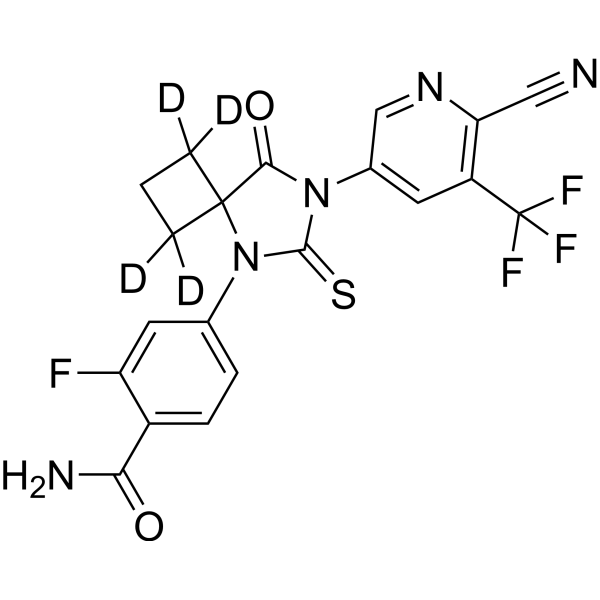
-
- HY-100641S
-
|
Hydroxytolbutamide-d9
|
Potassium Channel
Autophagy
|
Metabolic Disease
Cancer
|
|
4-Hydroxytolbutamide-d9 is the deuterium labeled 4-Hydroxytolbutamide. 4-Hydroxytolbutamide (Hydroxytolbutamide) is a metabolite of Tolbutamide. 4-Hydroxytolbutamide is metabolized by CYP2C8 and CYP2C9. Tolbutamide is a first generation potassium channel blocker and a sulfonylurea oral antidiabetic[1][2].
|
-
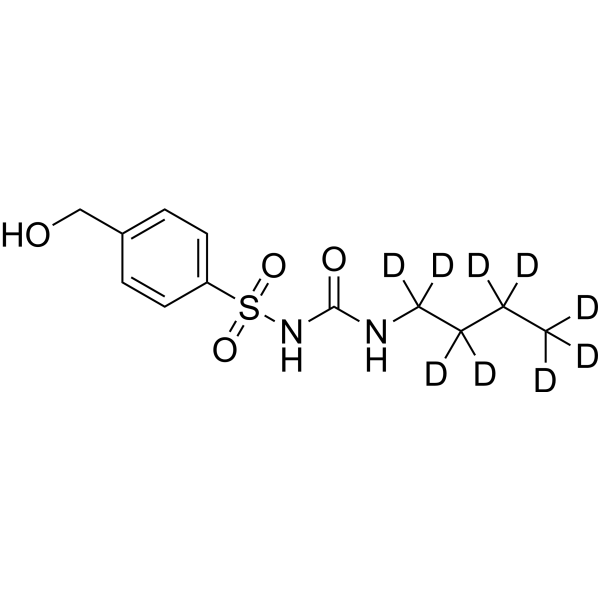
-
- HY-135334
-
|
|
Drug Metabolite
Btk
Cytochrome P450
|
Cancer
|
|
ACP-5862 is a major active, circulating, pyrrolidine ring-opened metabolite of Acalabrutinib with an IC50 of 5.0 nM for Bruton tyrosine kinase (BTK). ACP‐5862 is a weak time‐dependent inactivator of CYP3A4 and CYP2C8. Acalabrutinib is an orally active, irreversible, and highly selective BTK inhibitor, with an IC50 of 3 nM and EC50 of 8 nM .
|
-
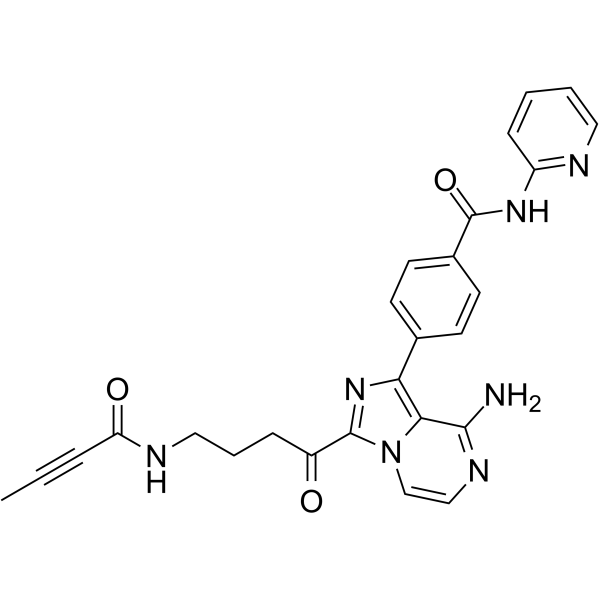
-
- HY-17356
-
Fenofibrate
Maximum Cited Publications
13 Publications Verification
|
PPAR
Cytochrome P450
Autophagy
|
Cardiovascular Disease
Cancer
|
|
Fenofibrate is a selective PPARα agonist with an EC50 of 30 μM. Fenofibrate also inhibits human cytochrome P450 isoforms, with IC50s of 0.2, 0.7, 9.7, 4.8 and 142.1 μM for CYP2C19, CYP2B6, CYP2C9, CYP2C8, and CYP3A4, respectively.
|
-
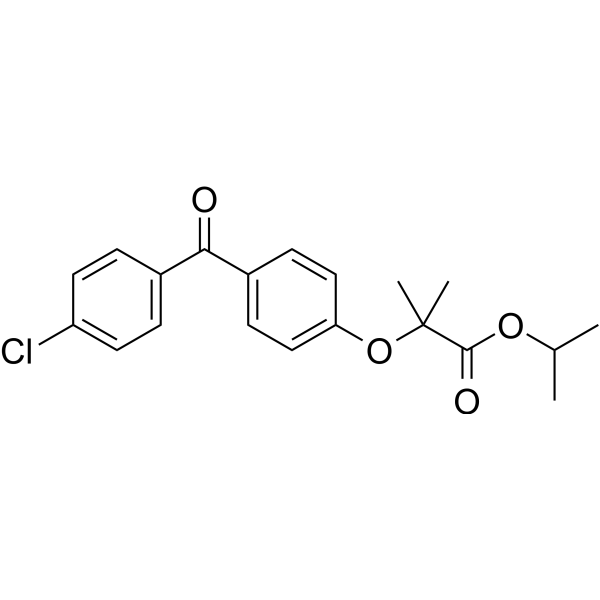
-
- HY-114759
-
|
|
Cytochrome P450
|
Neurological Disease
Metabolic Disease
Cancer
|
|
MS-PPOH is a potent and selective cytochrome P450 (CYP) epoxygenase inhibitor . MS-PPOH inhibits CYP2C8 and CYP2C9 with IC50s of 15 and 11 μM, respectively . MS-PPOH is a click chemistry reagent, it contains an Alkyne group and can undergo copper-catalyzed azide-alkyne cycloaddition (CuAAc) with molecules containing Azide groups.
|
-

-
- HY-135810S
-
|
Desethylhydroxychloroquine-d4
|
Isotope-Labeled Compounds
Influenza Virus
Parasite
|
Infection
Inflammation/Immunology
|
|
Cletoquine-d4 is deuterium labeled Cletoquine. Cletoquine (Desethylhydroxychloroquine) is a major active metabolite of Hydroxychloroquine. Cletoquine is produced in the liver by CYP2D6, CYP3A4, CYP3A5, and CYP2C8 isoenzymes. Cletoquine is also a Chloroquine derivative and has the ability to against the chikungunya virus (CHIKV). Cletoquine has antimalarial effects and has the potential for autoimmune diseases treatment[1][2].
|
-

-
- HY-135810S1
-
|
Desethylhydroxychloroquine-d4-1
|
Isotope-Labeled Compounds
Influenza Virus
Parasite
|
Infection
Inflammation/Immunology
|
|
Cletoquine-d4-1 is the deuterium labeled Cletoquine. Cletoquine (Desethylhydroxychloroquine) is a major active metabolite of Hydroxychloroquine. Cletoquine is produced in the liver by CYP2D6, CYP3A4, CYP3A5, and CYP2C8 isoenzymes. Cletoquine is also a Chloroquine derivative and has the ability to against the chikungunya virus (CHIKV). Cletoquine has antimalarial effects and has the potential for autoimmune diseases treatment[1][2].
|
-

-
- HY-17356S
-
-

-
- HY-135334S
-
|
|
Isotope-Labeled Compounds
Drug Metabolite
Btk
Cytochrome P450
|
Cancer
|
|
ACP-5862-d4 is deuterium labeled ACP-5862. ACP-5862 is a major active, circulating, pyrrolidine ring-opened metabolite of Acalabrutinib with an IC50 of 5.0 nM for Bruton tyrosine kinase (BTK). ACP‐5862 is a weak time‐dependent inactivator of CYP3A4 and CYP2C8. Acalabrutinib is an orally active, irreversible, and highly selective BTK inhibitor, with an IC50 of 3 nM and EC50 of 8 nM[1][2].
|
-

-
- HY-17356S1
-
|
|
PPAR
Autophagy
Cytochrome P450
|
|
|
Fenofibrate-d4 is the deuterium labeled Fenofibrate[1]. Fenofibrate is a selective PPARα agonist with an EC50 of 30 μM. Fenofibrate also inhibits human cytochrome P450 isoforms, with IC50s of 0.2, 0.7, 9.7, 4.8 and 142.1 μM for CYP2C19, CYP2B6, CYP2C9, CYP2C8, and CYP3A4, respectively[2][3].
|
-
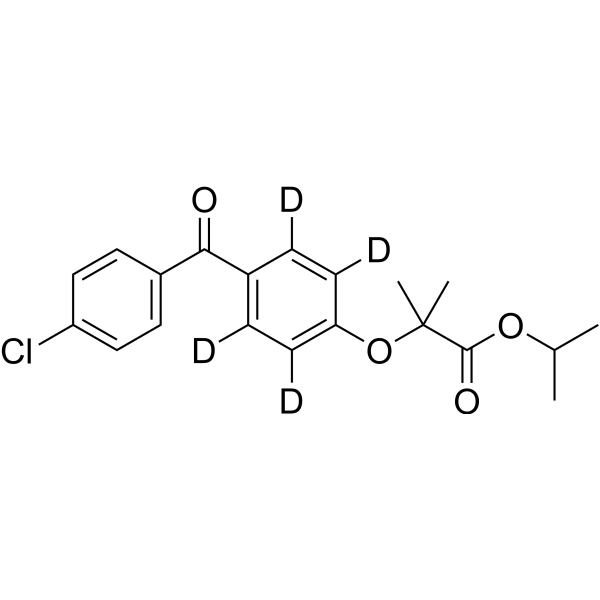
-
- HY-17356R
-
|
|
PPAR
Cytochrome P450
Autophagy
|
Cardiovascular Disease
Cancer
|
|
Fenofibrate (Standard) is the analytical standard of Fenofibrate. This product is intended for research and analytical applications. Fenofibrate is a selective PPARα agonist with an EC50 of 30 μM. Fenofibrate also inhibits human cytochrome P450 isoforms, with IC50s of 0.2, 0.7, 9.7, 4.8 and 142.1 μM for CYP2C19, CYP2B6, CYP2C9, CYP2C8, and CYP3A4, respectively.
|
-
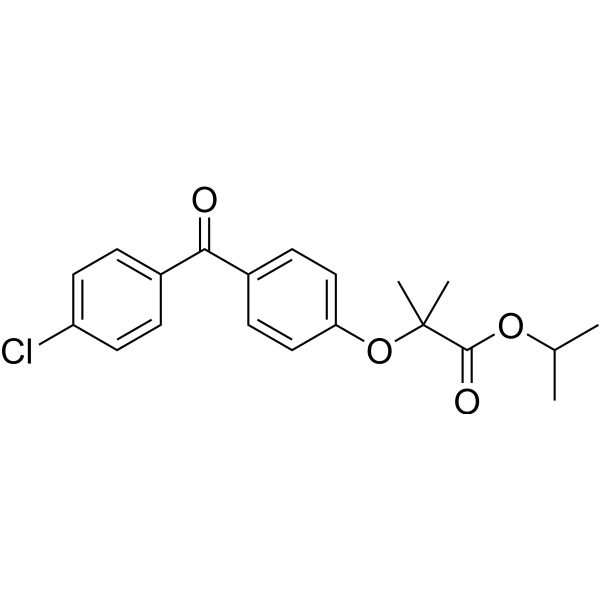
-
- HY-116862
-
|
DBF
|
Cytochrome P450
Fluorescent Dye
|
Others
|
|
Dibenzylfluorescein (DBF) is a fluorogenic probe (Fluoresecent dye) that acts as a substrate for specific cytochrome P450 (CYP) isoforms, including CYP3A4, CYP2C8, CYP2C9, CYP2C19, and aromatase (CYP19). Dibenzylfluorescein is typically used near its Km value of 0.87-1.9 µM (Ex=485nm,Em=535nm). Dibenzylfluorescein is used to detect changes in CYP catalytic activity caused by drugs or disease .
|
-
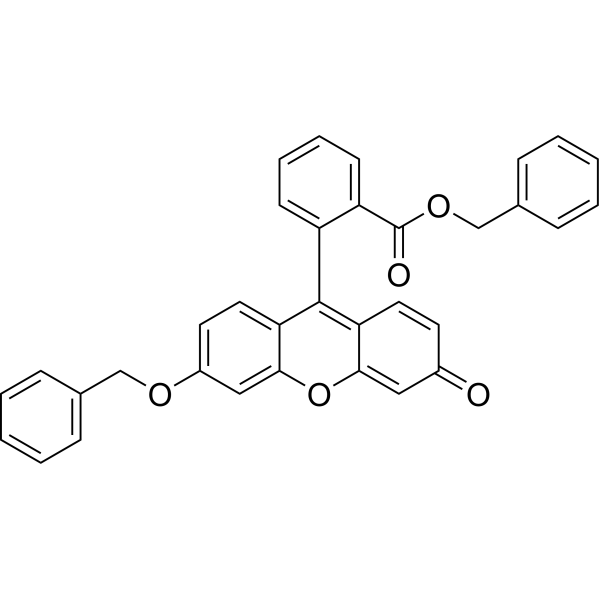
-
- HY-17356G
-
|
|
Cytochrome P450
PPAR
Autophagy
|
Cardiovascular Disease
|
|
Fenofibrate (GMP) is Fenofibrate (HY-17356) produced by using GMP guidelines. GMP small molecules work appropriately as an auxiliary reagent for cell therapy manufacture. Fenofibrate is a selective PPARα agonist with an EC50 of 30 μM. Fenofibrate also inhibits human cytochrome P450 isoforms, with IC50s of 0.2, 0.7, 9.7, 4.8 and 142.1 μM for CYP2C19, CYP2B6, CYP2C9, CYP2C8, and CYP3A4, respectively.
|
-
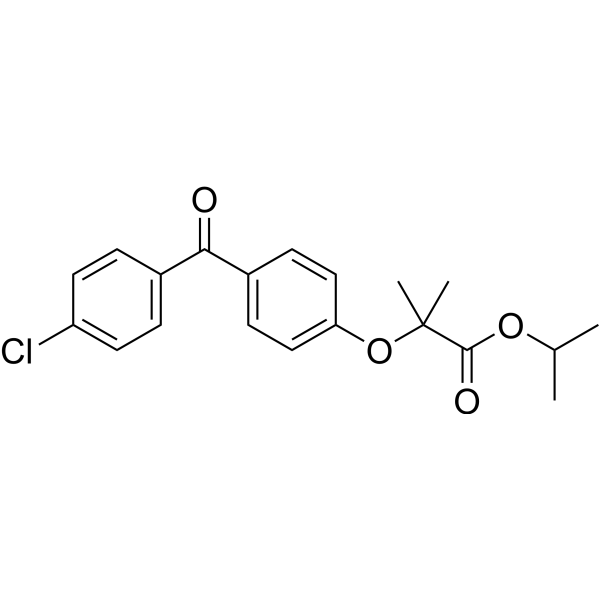
-
- HY-N2071
-
Cedrol
1 Publications Verification
(+)-Cedrol; α-Cedrol
|
Cytochrome P450
Fungal
|
Infection
Inflammation/Immunology
Cancer
|
|
Cedrol is a bioactive sesquiterpene, a potent competitive inhibitor of cytochrome P-450 (CYP) enzymes. Cedrol inhibits CYP2B6-mediated bupropion hydroxylase and CYP3A4-mediated midazolam hydroxylation with Ki of 0.9 μM and 3.4 μM, respectively. Cedrol also has weak inhibitory effect on CYP2C8, CYP2C9, and CYP2C19 enzymes . Cedrol is found in cedar essential oil and poetesses anti-septic, anti-inflammatory, anti-spasmodic, tonic, astringent, diuretic, insecticidal, and anti-fungal activities .
|
-
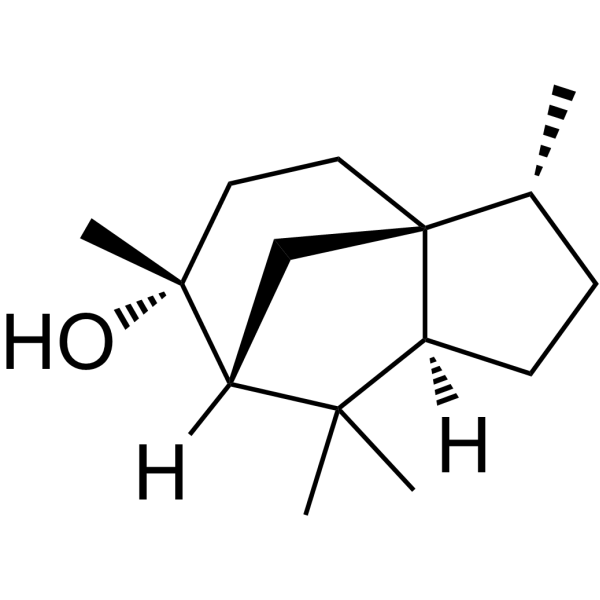
-
- HY-148352
-
|
|
PPAR
|
Cancer
|
|
BAY-4931 is a potent, covalent and selective PPARγ inverse-agonist with an IC50 of 0.17 nM .
|
-
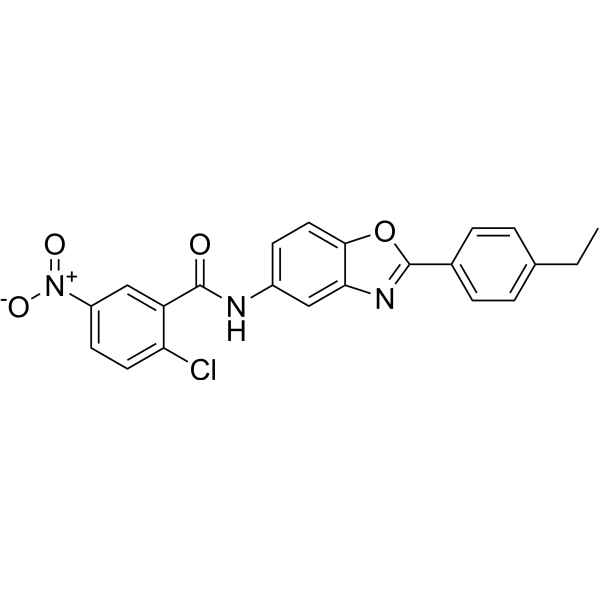
| Cat. No. |
Product Name |
Type |
-
- HY-116862
-
|
DBF
|
Fluorescent Dyes/Probes
|
|
Dibenzylfluorescein (DBF) is a fluorogenic probe (Fluoresecent dye) that acts as a substrate for specific cytochrome P450 (CYP) isoforms, including CYP3A4, CYP2C8, CYP2C9, CYP2C19, and aromatase (CYP19). Dibenzylfluorescein is typically used near its Km value of 0.87-1.9 µM (Ex=485nm,Em=535nm). Dibenzylfluorescein is used to detect changes in CYP catalytic activity caused by drugs or disease .
|
-
- HY-17356G
-
|
|
Fluorescent Dye
|
|
Fenofibrate (GMP) is Fenofibrate (HY-17356) produced by using GMP guidelines. GMP small molecules work appropriately as an auxiliary reagent for cell therapy manufacture. Fenofibrate is a selective PPARα agonist with an EC50 of 30 μM. Fenofibrate also inhibits human cytochrome P450 isoforms, with IC50s of 0.2, 0.7, 9.7, 4.8 and 142.1 μM for CYP2C19, CYP2B6, CYP2C9, CYP2C8, and CYP3A4, respectively.
|
| Cat. No. |
Product Name |
Type |
-
- HY-17356G
-
|
|
Biochemical Assay Reagents
|
|
Fenofibrate (GMP) is Fenofibrate (HY-17356) produced by using GMP guidelines. GMP small molecules work appropriately as an auxiliary reagent for cell therapy manufacture. Fenofibrate is a selective PPARα agonist with an EC50 of 30 μM. Fenofibrate also inhibits human cytochrome P450 isoforms, with IC50s of 0.2, 0.7, 9.7, 4.8 and 142.1 μM for CYP2C19, CYP2B6, CYP2C9, CYP2C8, and CYP3A4, respectively.
|
| Cat. No. |
Product Name |
Category |
Target |
Chemical Structure |
-
- HY-N0319
-
-

-
- HY-N2071
-
Cedrol
1 Publications Verification
(+)-Cedrol; α-Cedrol
|
Cedrus deodara (Roxburgh) G. Don
Classification of Application Fields
Pinaceae
Terpenoids
Sesquiterpenes
Source classification
Plants
Inflammation/Immunology
Disease Research Fields
Cancer
|
Cytochrome P450
Fungal
|
|
Cedrol is a bioactive sesquiterpene, a potent competitive inhibitor of cytochrome P-450 (CYP) enzymes. Cedrol inhibits CYP2B6-mediated bupropion hydroxylase and CYP3A4-mediated midazolam hydroxylation with Ki of 0.9 μM and 3.4 μM, respectively. Cedrol also has weak inhibitory effect on CYP2C8, CYP2C9, and CYP2C19 enzymes . Cedrol is found in cedar essential oil and poetesses anti-septic, anti-inflammatory, anti-spasmodic, tonic, astringent, diuretic, insecticidal, and anti-fungal activities .
|
-

| Cat. No. |
Product Name |
Chemical Structure |
-
- HY-135335S
-
|
|
|
3'-Hydroxy Repaglinide-d5 is the deuterium labeled 3'-Hydroxy Repaglinide. 3'-Hydroxy Repaglinide is a main CYP2C8 metabolite of Repaglinide[1].
|
-

-
- HY-W754151
-
|
|
|
N-Desmethyl apalutamide-d4 is the deuterium-labeled N-Desmethyl-Apalutamide (HY-135331). N-Desmethyl Apalutamide is an active metabolite of Apalutamide. N-Desmethyl Apalutamide is a less potent antagonist of the androgen receptor and is responsible for one-third of the activity of Apalutamide. The formation of N-Desmethyl Apalutamide mediated predominantly by CYP2C8 and CYP3A4. N-Desmethyl Apalutamide is moderate to strong CYP3A4 and CYP2B6 inducer and has an excellent plasma-proteins bound concentration .
|
-

-
- HY-100641S
-
|
|
|
4-Hydroxytolbutamide-d9 is the deuterium labeled 4-Hydroxytolbutamide. 4-Hydroxytolbutamide (Hydroxytolbutamide) is a metabolite of Tolbutamide. 4-Hydroxytolbutamide is metabolized by CYP2C8 and CYP2C9. Tolbutamide is a first generation potassium channel blocker and a sulfonylurea oral antidiabetic[1][2].
|
-

-
- HY-135810S
-
|
|
|
Cletoquine-d4 is deuterium labeled Cletoquine. Cletoquine (Desethylhydroxychloroquine) is a major active metabolite of Hydroxychloroquine. Cletoquine is produced in the liver by CYP2D6, CYP3A4, CYP3A5, and CYP2C8 isoenzymes. Cletoquine is also a Chloroquine derivative and has the ability to against the chikungunya virus (CHIKV). Cletoquine has antimalarial effects and has the potential for autoimmune diseases treatment[1][2].
|
-

-
- HY-135810S1
-
|
|
|
Cletoquine-d4-1 is the deuterium labeled Cletoquine. Cletoquine (Desethylhydroxychloroquine) is a major active metabolite of Hydroxychloroquine. Cletoquine is produced in the liver by CYP2D6, CYP3A4, CYP3A5, and CYP2C8 isoenzymes. Cletoquine is also a Chloroquine derivative and has the ability to against the chikungunya virus (CHIKV). Cletoquine has antimalarial effects and has the potential for autoimmune diseases treatment[1][2].
|
-

-
- HY-17356S
-
|
|
|
Fenofibrate-d6 is the deuterium labeled Fenofibrate. Fenofibrate is a selective PPARα agonist with an EC50 of 30 μM. Fenofibrate also inhibits human cytochrome P450 isoforms, with IC50s of 0.2, 0.7, 9.7, 4.8 and 142.1 μM for CYP2C19, CYP2B6, CYP2C9, CYP2C8, and CYP3A4, respectively.
|
-

-
- HY-135334S
-
|
|
|
ACP-5862-d4 is deuterium labeled ACP-5862. ACP-5862 is a major active, circulating, pyrrolidine ring-opened metabolite of Acalabrutinib with an IC50 of 5.0 nM for Bruton tyrosine kinase (BTK). ACP‐5862 is a weak time‐dependent inactivator of CYP3A4 and CYP2C8. Acalabrutinib is an orally active, irreversible, and highly selective BTK inhibitor, with an IC50 of 3 nM and EC50 of 8 nM[1][2].
|
-

-
- HY-17356S1
-
|
|
|
Fenofibrate-d4 is the deuterium labeled Fenofibrate[1]. Fenofibrate is a selective PPARα agonist with an EC50 of 30 μM. Fenofibrate also inhibits human cytochrome P450 isoforms, with IC50s of 0.2, 0.7, 9.7, 4.8 and 142.1 μM for CYP2C19, CYP2B6, CYP2C9, CYP2C8, and CYP3A4, respectively[2][3].
|
-

| Cat. No. |
Product Name |
|
Classification |
-
- HY-114759
-
|
|
|
Alkynes
|
|
MS-PPOH is a potent and selective cytochrome P450 (CYP) epoxygenase inhibitor . MS-PPOH inhibits CYP2C8 and CYP2C9 with IC50s of 15 and 11 μM, respectively . MS-PPOH is a click chemistry reagent, it contains an Alkyne group and can undergo copper-catalyzed azide-alkyne cycloaddition (CuAAc) with molecules containing Azide groups.
|
Your information is safe with us. * Required Fields.
Inquiry Information
- Product Name:
- Cat. No.:
- Quantity:
- MCE Japan Authorized Agent:
































